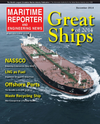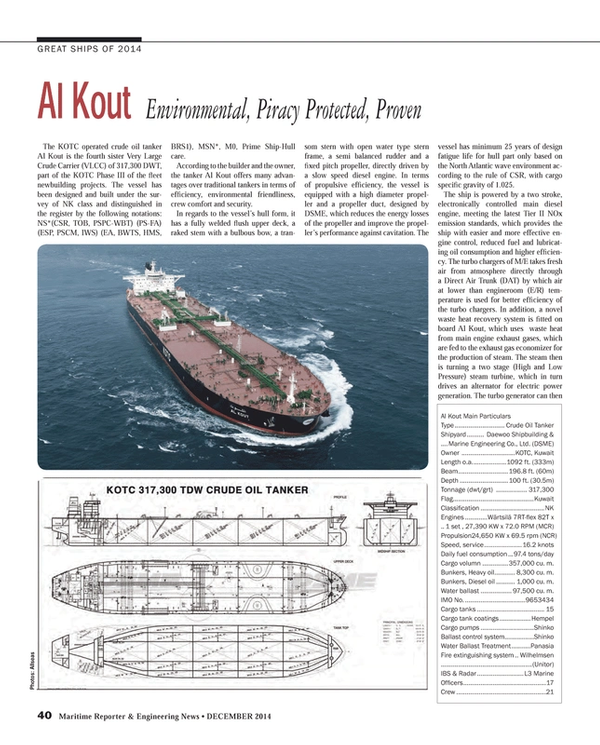
Great Ships of 2014: Al Kout Environmental, Piracy Protected, Proven
The KOTC operated crude oil tanker Al Kout is the fourth sister Very Large Crude Carrier (VLCC) of 317,300 DWT, part of the KOTC Phase III of the fleet newbuilding projects. The vessel has been designed and built under the survey of NK class and distinguished in the register by the following notations: NS*(CSR, TOB, PSPC-WBT) (PS-FA) (ESP, PSCM, IWS) (EA, BWTS, HMS, BRS1), MSN*, M0, Prime Ship-Hull care.
According to the builder and the owner, the tanker Al Kout offers many advantages over traditional tankers in terms of efficiency, environmental friendliness, crew comfort and security.
In regards to the vessel’s hull form, it has a fully welded flush upper deck, a raked stem with a bulbous bow, a transom stern with open water type stern frame, a semi balanced rudder and a fixed pitch propeller, directly driven by a slow speed diesel engine. In terms of propulsive efficiency, the vessel is equipped with a high diameter propeller and a propeller duct, designed by DSME, which reduces the energy losses of the propeller and improve the propeller’s performance against cavitation. The vessel has minimum 25 years of design fatigue life for hull part only based on the North Atlantic wave environment according to the rule of CSR, with cargo specific gravity of 1.025.
The ship is powered by a two stroke, electronically controlled main diesel engine, meeting the latest Tier II NOx emission standards, which provides the ship with easier and more effective engine control, reduced fuel and lubricating oil consumption and higher efficiency. The turbo chargers of M/E takes fresh air from atmosphere directly through a Direct Air Trunk (DAT) by which air at lower than engineroom (E/R) temperature is used for better efficiency of the turbo chargers. In addition, a novel waste heat recovery system is fitted on board Al Kout, which uses waste heat from main engine exhaust gases, which are fed to the exhaust gas economizer for the production of steam. The steam then is turning a two stage (High and Low Pressure) steam turbine, which in turn drives an alternator for electric power generation. The turbo generator can then be run in parallel with the other two diesel generators, forming the vessel’s power generation plant. The turbo generator also has the ability to operate with direct steam generated from the auxiliary boilers in case that the main engine load is low or when the M/E is stopped. The heat from M/E air cooler is used to heat the Feed Water for WHRS system adding to overall energy saving. Further the condensate from T/G vacuum condenser is pre-heated by M/E jacket water cooling system before returning to cascade tank.
KOTC has ordered the vessel with several improvements in the field of electric power consumption. More specifically, an energy saving system (ESS) is installed on board the ship, a system which uses a variable frequency motor drive (inverter) for each main cooling sea water pump to reduce the motor power consumption by varying the frequency of the motors according to the cooling capacity requirements. The accommodation air condition system blowers are also provided with variable frequency drive to optimize room temperature while saving as much energy as possible. Additionally, the full accommodation area is fitted with LED type lights for improved illumination and reduced power consumption and the normal lights in E/R is designed to switch off automatically when the E/R is in unmanned state.
The environmental friendly character of the vessel has been a top priority at all stages of design and hence KOTC has taken the initiative to install a Ballast Water Treatment System (BWTS), which uses filtration and UV disinfection technology to minimize the impact on the local marine ecosystems.
In addition, the vessel is equipped with a Volatile Organic Compounds reduction system (De-VOC) to minimize the generation of volatile organic compounds, especially at the initial stage of cargo loading. The selection of the Wärtsilä RT-flex main engine, diesel generator engines and waste heat recovery system further reduce the exhaust gas emissions from the vessel and thus reduce her carbon footprint. The vessel’s main engine and diesel generator engines emissions are continuously monitored by the emission monitoring system fitted on Al Kout, using sampling probes installed on each exhaust gas piping. A bio-oil based stern tube lubrication system is used for making the vessel more eco-friendly. The vessel is built ready for using fuel oil with 0.1 % sulfur to meet the upcoming stringent SECA requirements. It is worth noting further that KOTC have gone into minute details for protecting the environment by installing a VOC Control (VOCON) system to control and minimize VOC release during the passage of the vessel.
On the ship’s security and anti-piracy front, the vessel is provided with all the latest technology against piracy. Specifically, the long range anti-piracy measures include an innovative acoustic hailing device, which is used to deter and delay any attacking pirate boat by transmitting directional sound waves towards the attacking boat, after broadcasting warning messages. Short range measures consist of portable high pressure water jet cannons, anti-intrusion barriers (AIB), secure accommodation arrangement (enclosed ladder trunks at both port and starboard) at all possible accommodation accesses and designated citadel area with emergency communication equipment.
The surveillance of the spaces on board as well as in the vicinity of the vessel are monitored by a CCTV system at three control positions, which includes 16 cameras installed at key positions.
In addition to technical outfit, Al Kout – per MLC 2006 – is well outfitted for crew comfort. Among others, the crew can enjoy an indoor swimming pool with pyramid shape glass roof, sauna, large and fully equipped gymnasium and sports room, high speed broadband internet connection, on board entertainment system and satellite television. The accommodation spaces are also selected and constructed to a very high standard with spacious cabins and communal areas.
The ship features a centralized control, alarm and monitoring system (CAMS) includes more than 1,800 monitored parameters, instantly providing the engine and deck officers with all necessary information and adequately protecting all machineries on board.
An oil mist detector system is incorporated in E/R to continuously monitor and detect all strategic areas in the engine room for any possible mist formation. Provisions have been made for the easy retrofit of an alternative marine power (AMP) system at any future stage, which will allow the supply of the total necessary electric power from shore while at port. Another noteworthy design feature of Al Kout is that all equipment in accommodation spaces and control stations (engine control room, cargo control room, wheel house) are designed on the basis of ambient temperature of 45o C, while alternators, motors and cables in engine room are designed and manufactured on the basis of ambient temperature of 55 degrees C.
Al Kout Main Particulars
Type Crude Oil Tanker
Shipyard Daewoo Shipbuilding &
Marine Engineering Co., Ltd. (DSME)
Owner KOTC, Kuwait
Length o.a. 1092 ft. (333m)
Beam 196.8 ft. (60m)
Depth 100 ft. (30.5m)
Tonnage (dwt/grt) 317,300 Flag Kuwait
Classification NK
Engines Wärtsilä 7RT-flex 82T x
1 set , 27,390 KW x 72.0 RPM (MCR)
Propulsion 24,650 KW x 69.5 rpm (NCR)
Speed, service 16.2 knots
Daily fuel consumption 97.4 tons/day
Cargo volumn 357,000 cu. m.
Bunkers, Heavy oil 8,300 cu. m.
Bunkers, Diesel oil 1,000 cu. m.
Water ballast 97,500 cu. m.
IMO No. 9653434
Cargo tanks 15
Cargo tank coatings Hempel
Cargo pumps Shinko
Ballast control system Shinko
Water Ballast Treatment Panasia
Fire extinguishing system Wilhelmsen (Unitor)
IBS & Radar L3 Marine
Officers 17
Crew 21
(As published in the December 2014 edition of Maritime Reporter & Engineering News -
)
Read Great Ships of 2014: Al Kout Environmental, Piracy Protected, Proven in Pdf, Flash or Html5 edition of December 2014 Maritime Reporter
Other stories from December 2014 issue
Content
- Satellites Reveal Worldwide Ship Traffic Up 300% page: 10
- Bulk Carrier Freight Rates Predicted to Peak in 2016 page: 12
- MLC2006 Impact: 113 Ships Detained page: 13
- Maritime Quarantine & Isolation page: 16
- FPSOs Require Special Monitoring to Support IMR page: 18
- As Interest in LNG Surges, Regulators Struggle to Keep Pace page: 20
- NASSCO: The Face of US Shipbuilding page: 24
- Hempel: Born in Maritime page: 29
- Since 1927, The Damen Way page: 30
- Air Products: Pioneering Gas Processing Solutions page: 32
- Alfa Laval: Keeping it Clean page: 33
- R.W. Fernstrum: Keeping it Cool page: 34
- MAN Diesel & Turbo: Power Play page: 35
- MLS: eLearning Re-thought page: 36
- Great Ships of 2014: Al Kout Environmental, Piracy Protected, Proven page: 40
- Great Ships of 2014: Allseas’ Pieter Schelte page: 42
- Great Ships of 2014: CSCL Globe - world’s largest containership page: 44
- Great Ships of 2014: Harvey Energy page: 45
- Great Ships of 2014: Quantum of the Seas page: 46
- Great Ships of 2014: The Hybrid-Powered Semper Fi page: 47
- Great Ships of 2014: Ceona Amazon page: 48
- Great Ships of 2014: R/V Neil Armstrong - Multifaceted Sea Explorer page: 50
- Great Ships of 2014: Linda Oldendorff page: 51
- Great Ships of 2014: CSAV Tyndall page: 52
- Great Ships of 2014: Top Coral Do Atlantico - A 'Mega' Pipelayer page: 52
- Great Ships of 2014: Linda Oldendorff page: 53
- Great Ships of 2014: Harvest Frost page: 53
- Great Ships of 2014: Gas Star - 84,000 CBM LPG Carrier page: 54
- Great Ships of 2014: M/V Harvest Leader - ECO Class PCTC page: 55
- Lindenau’s Concept: Waste Recycling Ships page: 56
- Great ships of 2014: Siem Moxie page: 57
- Great Ships of 2014: Höegh Jacksonville page: 57
- Are Offshore Ports the Future? page: 58
- Marine Lubricants: New Year, New Emission Rules page: 62
- Phoenix EcoMod 450 Floodlight page: 71
- MES, Viking Yachts Partner for Quiet Performance page: 71
- Air Purifying System for Tug-turned-superyacht page: 71
- Norsafe for Pieter Schelte page: 71
- EnviroLogic: SVGP Compliant Fluids & Cleaners page: 71
- ExxonMobil Debuts Zinc-free Marine Engine Oil page: 71
- Water Reclamation System Delivered to Transocean page: 71
- Ocean Signal Debuts RescueME EPIRB1 page: 71
- NEW EAL from Shell: Naturelle Stern Tube Fluid page: 71
- Inventor. Builder. Entrepreneur. Optimist. Schweitzer page: 86


